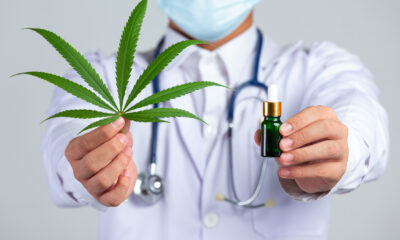Health
The Hidden Dangers of Ignoring Blisterata: Why Proper Care is Essential
Published
9 months agoon

Are you familiar with Blisterata? No, it’s not a rare tropical disease or a mythical creature – it’s something that can affect anyone, anywhere. In this blog post, we’ll uncover the hidden dangers of ignoring Blisterata and why proper care is essential. So, buckle up as we dive into this seemingly harmless yet potentially troublesome condition that could be lurking right under your nose (or on your feet)!
What is Blisterata?
Blisterata is not your average run-of-the-mill blister – it’s a condition that goes beyond just uncomfortable footwear rubbing. This sneaky ailment can occur when friction, moisture, and pressure team up to wreak havoc on your skin. Picture those pesky blisters you get from shoes that just won’t cooperate, but on steroids.
When Blisterata strikes, it manifests as painful fluid-filled sacs beneath the top layer of skin. These blisters are not only unsightly but can also be downright agonizing, making every step feel like a trek through a bed of hot coals.
So next time you notice what seems like an innocent blister forming, don’t brush it off as no big deal. It could be the early stages of Blisterata plotting its takeover on your skin!
Symptoms and Causes of Blisterata
Blisterata, although not widely known, can present with various symptoms that shouldn’t be ignored. The first sign is typically the appearance of small fluid-filled blisters on the skin, often accompanied by redness and tenderness. These blisters can cause discomfort and pain if left untreated.
The causes of Blisterata can vary from friction due to ill-fitting shoes or clothing to excessive moisture trapped against the skin. Additionally, burns, insect bites, or allergic reactions can also trigger blister formation. Understanding these triggers is crucial in preventing future occurrences.
It’s important to recognize the symptoms early on and identify potential causes to address them effectively. Seeking medical advice for proper diagnosis and treatment is essential in managing Blisterata before it worsens. By taking proactive steps in care and prevention, individuals can minimize the impact of this condition on their daily lives.
The Dangers of Ignoring Blisterata
Ignoring Blisterata can lead to more severe complications than just discomfort. When left untreated, blisters can become infected, causing pain and potential scarring. The fluid-filled sacs may burst open, increasing the risk of infection as well as delaying the healing process.
Moreover, ignoring Blisterata could result in prolonged inflammation and potentially hinder normal skin regeneration. This delay in recovery might interfere with daily activities such as walking or wearing shoes comfortably. The risk of developing secondary infections from open blisters is also a concern when proper care is not administered promptly.
In some cases, neglecting Blisterata could even lead to systemic infections if bacteria enter the bloodstream through broken blisters. It’s crucial to address any signs of blister formation early on to prevent these risks and ensure a speedy and uncomplicated recovery process for your skin health.
Proper Care for Blisterata
When it comes to proper care for Blisterata, taking action early is key. Begin by cleaning the affected area with mild soap and warm water, avoiding harsh chemicals that can irritate the skin further. Once clean, gently pat the area dry and avoid friction or pressure on the blister.
Next, consider applying a bandage or dressing to protect the blister from rubbing against shoes or clothing. Opt for breathable materials to promote healing and prevent infection. If the blister breaks open, keep it clean and apply an antibacterial ointment before covering it with a fresh bandage.
Avoid popping blisters yourself as this can increase the risk of infection. Instead, allow them to heal naturally while keeping them protected and clean. Monitor for signs of infection such as increased pain, redness, or discharge – if any occur, seek medical attention promptly.
Remember that proper care plays a crucial role in preventing complications and promoting faster healing of Blisterata.
Prevention Strategies
Prevention strategies play a crucial role in managing Blisterata and reducing the risk of developing this painful condition. One key strategy is to ensure proper footwear that fits well and provides adequate support. Avoiding friction by wearing moisture-wicking socks can also help prevent blisters from forming.
Regularly inspecting your feet for any signs of redness or irritation can catch potential issues early on. Keeping your skin moisturized but not excessively wet can also aid in preventing blisters. For athletes or individuals engaging in physical activities, using protective padding on areas prone to rubbing can be beneficial.
Furthermore, maintaining good foot hygiene by keeping feet clean and dry, as well as trimming toenails properly, are simple yet effective prevention measures. Listening to your body’s signals and addressing any discomfort promptly can prevent minor issues from escalating into more serious blister problems. By incorporating these preventive strategies into your routine, you can take proactive steps towards avoiding the hidden dangers of Blisterata.
Impact on Daily Life and Activities
Living with Blisterata can significantly impact daily life and activities. The discomfort and pain caused by blisters can make simple tasks like walking, exercising, or even wearing shoes unbearable. It can hinder mobility and limit your ability to participate in activities you enjoy.
The constant reminder of blisters on your feet can be mentally exhausting as well, affecting your mood and overall quality of life. Simple things like standing for long periods or wearing certain types of footwear become a challenge that needs careful consideration.
Moreover, untreated blisters from Blisterata have the potential to lead to more serious infections if not properly cared for. This could result in prolonged discomfort, extended recovery times, and potentially costly medical treatments.
Don’t underestimate the impact that Blisterata can have on your daily routine. Taking proactive steps to address blisters promptly is crucial in maintaining comfort and preventing further complications.
Conclusion: Don’t Ignore Blisterata
Taking care of Blisterata is crucial for your health and well-being. Ignoring the symptoms can lead to serious complications and impact your daily life. By understanding the causes, symptoms, proper care, and prevention strategies for Blisterata, you can ensure a quicker recovery and avoid future outbreaks. Remember, don’t ignore Blisterata – prioritize proper care to stay healthy and active.
You may like
-


How Water Contamination Incidents Can Lead to Widespread Health Crises
-


The Ultimate Guide: How Long Do Shrooms Last in Your System?
-


How Alevemente is Revolutionizing the Self-Care Industry
-


The Science Behind Chancerne: What You Need to Know
-


Spice Up Your Life with Spicyrranny: How to Add Heat to Your Meals
-


Healing Mind, Body, and Spirit with Kecveto: A Comprehensive Overview
Health
The Role and Evolution of Pharmacies in Modern Healthcare
Published
3 weeks agoon
October 30, 2024
The Role and Evolution of Pharmacies in Modern Healthcare are integral to healthcare systems worldwide, providing essential services that go beyond merely dispensing medications. As the role of healthcare providers expands, so does the role of pharmacies and pharmacists. From traditional brick-and-mortar pharmacies to innovative online solutions, pharmacies are evolving to meet the changing needs of consumers and the demands of modern healthcare.
1. The History and Evolution of Pharmacies
The Role and Evolution of Pharmacies have a rich history, tracing back thousands of years to ancient civilizations like Egypt, China, and Greece, where herbal remedies and medicinal practices were first developed. Apothecaries in medieval Europe played a similar role to modern-day pharmacists, preparing and selling medications.
With the advent of modern medicine and pharmaceuticals, pharmacies transitioned from solely providing natural remedies to compounding and dispensing a wider range of medications. By the 19th and 20th centuries, pharmacists gained professional recognition, and the field began requiring rigorous training and licensing. Today, pharmacies not only provide medications but also offer a variety of health services, including immunizations, health screenings, and consultations.
2. Types of Pharmacies
There are several types of The Role and Evolution of Pharmacies, each tailored to specific needs and patient populations:
Retail Pharmacies
Retail The Role and Evolution of Pharmacies, often located in drug stores, grocery stores, and independent shops, are the most common type. These pharmacies provide prescription medications, over-the-counter drugs, and various health-related products. Retail pharmacies often have pharmacists available for consultations, medication reviews, and advice on managing chronic conditions.
Hospital Pharmacies
Located within hospitals, these pharmacies focus on the unique needs of inpatients. Hospital pharmacists work closely with doctors and nurses to ensure patients receive the correct medications and dosages. They may also monitor drug interactions and side effects, making hospital pharmacies critical for acute care.
Clinical Pharmacies
Clinical pharmacies are often found in healthcare facilities and focus on direct patient care. Clinical pharmacists are integral to patient management, collaborating with doctors to create treatment plans and adjust medications based on individual needs. They may also work in specialized clinics for chronic conditions, such as diabetes, hypertension, and HIV/AIDS.
Compounding Pharmacies
Compounding pharmacies create customized medications tailored to patients’ unique needs. They are essential for patients with allergies to certain ingredients, those who require specific dosages not available in mass-produced medications, or those who need alternative delivery methods, such as creams or lozenges. Compounding requires special training and facilities to ensure patient safety and efficacy.
Online and Mail-Order Pharmacies
Online and mail-order pharmacies have grown in popularity due to their convenience, especially for individuals who need regular medication refills or live in remote areas. They offer an extensive range of prescription and non-prescription medications, delivered directly to the patient’s home. While convenient, these pharmacies also pose risks, as not all online pharmacies are legitimate.
3. Key Roles of Pharmacists in Healthcare
Pharmacists play multiple roles beyond simply dispensing medication:
Medication Management
Pharmacists ensure that patients receive the right medications in the correct doses. They verify prescriptions, check for potential interactions, and provide instructions on proper medication use. Pharmacists are also responsible for managing medication therapy for chronic diseases, helping patients to improve adherence to their treatment plans.
Patient Education and Counseling
Pharmacists educate patients on medication side effects, interactions, and proper usage. This is particularly important for those on complex medication regimens or those with chronic conditions requiring lifelong treatment. Educating patients helps reduce medication errors and improves patient outcomes.
Immunizations and Preventative Care
In many regions, pharmacists are authorized to administer vaccines, including flu shots, COVID-19 vaccines, and travel immunizations. This expansion of pharmacy services has improved access to preventative care, especially in rural and underserved areas. In some countries, pharmacists are also involved in health screenings for conditions such as hypertension and diabetes.
Emergency and After-Hours Services
Some pharmacies offer 24/7 services, providing access to medications and advice during emergencies. These pharmacies can be crucial for individuals needing immediate access to medications for acute conditions or those requiring urgent consultations.
4. Challenges Facing the Pharmacy Industry
While pharmacies are indispensable, they face several challenges:
Rising Drug Prices
One of the biggest issues in the pharmacy industry is the rising cost of medications, which can make essential treatments unaffordable for many. Pharmacists are often caught between wanting to help patients access necessary medications and the financial realities of healthcare costs. Some pharmacists work with patients and doctors to find affordable alternatives or offer discount programs.
Shortages of Qualified Pharmacists
The demand for pharmacists continues to rise, but there is a shortage of qualified professionals, especially in rural areas. This shortage strains existing pharmacy staff, leading to increased workloads, which can compromise patient care.
Regulatory and Legal Challenges
Pharmacies must navigate a complex web of regulations, particularly in areas such as controlled substances and online sales. Staying compliant requires substantial resources and can be especially challenging for independent pharmacies that lack the legal teams of larger corporations.
The Impact of Technology
While technology has enabled advances in pharmacy services, it also introduces challenges. For instance, some patients may misuse online platforms to obtain medications without proper oversight. There is also concern about patient privacy, as electronic health records and online pharmacy accounts are vulnerable to data breaches.
5. Technological Advancements in Pharmacies
The pharmacy industry has seen significant technological advancements in recent years:
Automation and Robotics
Many pharmacies use automated dispensing systems to improve accuracy and efficiency. Robots can sort, count, and package medications, reducing the risk of human error and allowing pharmacists to focus on patient care.
Telepharmacy
Telepharmacy is a growing field, allowing pharmacists to provide remote consultations and support to patients. This is particularly useful in rural areas where pharmacy services may be limited. Telepharmacy also offers convenience, allowing patients to consult pharmacists from the comfort of their homes.
Electronic Prescriptions and Digital Health Records
Electronic prescriptions have streamlined the prescription process, reducing wait times and minimizing errors due to illegible handwriting. Digital health records allow pharmacists to access a patient’s complete medical history, helping them make informed decisions regarding medication management.
Mobile Health Applications
Some pharmacies now offer mobile applications, allowing patients to refill prescriptions, receive medication reminders, and access health information. These apps enhance medication adherence, improve patient engagement, and allow for better communication between patients and pharmacists.
6. The Future of Pharmacies
The role of pharmacies is expected to expand as healthcare needs evolve. Potential future developments include:
Increased Role in Primary Care
With physician shortages and rising healthcare costs, pharmacists may take on an expanded role in primary care. This could include managing chronic conditions, conducting routine health screenings, and even prescribing medications for minor conditions in some regions.
Focus on Preventative Health
As healthcare systems shift from reactive to preventive care, pharmacies will play a crucial role in educating the public on healthy lifestyles, vaccinations, and early detection of chronic diseases.
Personalized Medicine and Genomics
With the growth of personalized medicine, pharmacists may increasingly be involved in tailoring medications based on genetic information. Pharmacists could help interpret pharmacogenomic tests, guiding patients toward the most effective medications with the fewest side effects.
7. Conclusion
Pharmacies are a critical component of healthcare systems, evolving to meet the needs of a changing world. From medication management and patient education to telepharmacy and personalized care, the role of pharmacies has expanded significantly. As technology continues to advance and healthcare demands grow, pharmacies will undoubtedly adapt, further solidifying their position as pillars of patient health and well-being. With their ability to bridge the gap between patients and complex healthcare systems, pharmacies are essential to accessible, quality care for all.

TG-tube.—–Tube Gastrostomy (TG Tube): Purpose, Procedure, and Essential Care Tips
Introduction
(TG Tube) Gastrostomy (TG Tube) is a medical procedure that involves the insertion of a tube into the stomach to provide necessary nutrition to patients who cannot eat orally. This procedure, commonly known as a “G-tube,” is often recommended for individuals with medical conditions that impede normal feeding. In this article, we’ll discuss what TG tubes are, why they’re used, how the procedure is performed, care tips, potential risks, and answers to common questions.
What is a TG Tube?
A Tube Gastrostomy (TG ) is a small, flexible tube surgically placed directly into the stomach through an opening in the abdominal wall. The main purpose of a TG tube is to deliver food, fluids, and medications directly into the stomach for patients who cannot safely or effectively swallow. Conditions that may require a TG tube include neurological disorders, certain cancers, or severe trauma affecting the mouth or throat.
Why is a TG Tube Needed?
A TG is typically recommended for patients who:
- Have Swallowing Difficulties: Conditions like ALS, stroke, or certain cancers can impair swallowing.
- Need Long-Term Nutritional Support: Some conditions, such as cystic fibrosis or Crohn’s disease, can make oral feeding difficult or insufficient.
- Suffer from Recurrent Aspiration Pneumonia: Patients who inhale food or liquid into their lungs risk recurrent lung infections and may benefit from a tube.
- Require Nutritional Supplements: Patients unable to meet their caloric needs orally due to severe malnutrition or failure to thrive can benefit from TG feeding.
The Procedure: How a TG Tube is Placed
The TG tube placement procedure is performed by a surgeon or gastroenterologist, typically under anesthesia, and usually follows these steps:
- Preparation: The patient is given anesthesia, and the abdominal area is cleaned and sterilized.
- Incision and Tube Placement: A small incision is made in the upper abdomen, and the TG is carefully inserted through the incision and into the stomach.
- Securing the Tube: Once the tube is in place, it’s secured to the abdominal wall to prevent dislodgment.
- Verification: The placement is verified via imaging (such as X-ray or endoscopy) to ensure that the tube is correctly positioned in the stomach.
- Post-Procedure Observation: After placement, the patient may be monitored for any signs of complications, such as infection or leakage around the tube.
In some cases, a percutaneous endoscopic gastrostomy (PEG) is used to place the TG with the assistance of an endoscope—a flexible tube with a camera that allows the physician to see the inside of the stomach.
Types of TG Tubes
There are different types of gastrostomy tubes, each with unique features suited to specific needs:
- Balloon-Style Tubes: These tubes use a small balloon at the end to hold them in place inside the stomach.
- Non-Balloon Tubes: These tubes are held in place by a small flange rather than a balloon.
- Low-Profile Tubes (Buttons): These are smaller and more discreet, ideal for long-term use and improved comfort.
TG Tube Care Tips
Proper care of the TG tube and the surrounding area is crucial to prevent infections and other complications. Here are some essential care tips:
- Keep the Area Clean and Dry: Gently clean around the tube daily with mild soap and water, ensuring the area remains dry afterward.
- Inspect for Signs of Infection: Redness, swelling, or discharge around the tube site may indicate an infection. Seek medical attention if any of these symptoms appear.
- Flush the Tube Regularly: To prevent clogging, flush the tube with warm water before and after each feeding or medication administration.
- Follow Feeding Guidelines: Use the prescribed formula and follow the recommended feeding schedule and amounts to avoid complications like bloating, vomiting, or diarrhea.
- Secure the Tube: Use medical tape or a securement device to keep the tube in place, reducing the risk of accidental dislodgement.
Common Complications and Risks
While TG tubes are generally safe, there are potential risks and complications that may arise, such as:
- Infection: Infection at the TG tubes insertion site is one of the most common risks. Proper cleaning and monitoring can help prevent infections.
- Tube Dislodgment: Accidental tube dislodgment can lead to complications, especially if it occurs soon after surgery. Securing the TG tube and handling it carefully are essential.
- Blockages: TG tubes can become clogged, particularly if not flushed regularly. Water flushes help reduce this risk.
- Skin Irritation and Leakage: TG Leakage of gastric fluids around the tube site can cause skin irritation. Barrier creams and regular cleaning can help alleviate this issue.
- Granulation Tissue: This is extra tissue that can develop around the tube site, leading to discomfort and sometimes requiring treatment by a healthcare provider.
Frequently Asked Questions
1. How long does a TG tube last?
A TG tube can last from several months to a year, depending on the type and care. Low-profile tubes typically require replacement every 6-12 months, while other types may last longer.
2. Can patients with a TG tube eat or drink orally?
Some patients with a TG tube can still consume small amounts of food or drink orally, depending on their specific medical condition. However, others may rely entirely on tube feeding.
3. How should the tube be cleaned?
The tube should be flushed with warm water before and after each use. External components should be cleaned daily with mild soap and water.
4. What should be done if the tube becomes clogged?
Attempt to flush the tube with warm water. If the clog persists, contact a healthcare provider rather than trying to clear it with excessive force.
5. Is a TG tube painful?
During the initial healing period, mild discomfort may occur. Once healed, the tube is generally comfortable, but irritation or infection can cause discomfort.
Conclusion
Tube Gastrostomy ( tube.) is a vital medical solution for patients who cannot eat or drink by mouth. With proper care and maintenance, a TG can improve quality of life by ensuring consistent and safe nutritional intake. While the procedure does carry some risks, most can be managed with diligent care, regular cleaning, and timely medical support. If you or a loved one are considering TG-tube placement, consult a healthcare professional to understand the best options, expected outcomes, and ways to provide effective ongoing care.
This article provides an overview of TG tubes and the essential information needed to understand the procedure and manage it effectively. Always follow medical advice tailored to individual needs and consult healthcare professionals with any concerns
entertainment
The Importance of Gym Workouts for a Healthy Lifestyle
Published
4 weeks agoon
October 24, 2024
The Importance of Gym Workouts for a Healthy Lifestyle has become a cornerstone of modern fitness culture, offering individuals a dedicated space to work on their physical health. Whether it’s for weight loss, muscle gain, or simply to stay active, gyms provide a wide variety of equipment, classes, and environments that cater to diverse fitness needs. This article explores the multifaceted benefits of gym workouts, how to get started, and the best practices for maximizing your time at the gym.
Benefits of Regular Gym Workouts
1. Physical Health Benefits
Regular gym workouts have significant positive effects on physical health. One of the most obvious benefits is cardiovascular health. Engaging in aerobic activities like running on the treadmill, cycling, or participating in group fitness classes can help improve heart function, lower blood pressure, and reduce the risk of heart diseases. Strength training, on the other hand, helps build muscle mass, strengthen bones, and improve joint flexibility.
Moreover, regular gym-goers often experience better posture, reduced back pain, and increased mobility. For individuals looking to lose weight, consistent exercise combined with a balanced diet accelerates fat loss while preserving lean muscle mass. the Importance of Gym Workouts for a Healthy life style offer an ideal environment to combine both cardio and strength training, helping individuals achieve a well-rounded fitness level.
2. Mental Health Benefits
the Importance of Gym Workouts for a Healthy Lifestyle In addition to physical health, exercise has been shown to have profound benefits for mental well-being. Going to the gym and engaging in regular workouts can reduce symptoms of depression, anxiety, and stress. Exercise triggers the release of endorphins, often referred to as the body’s “feel-good” hormones, which boost mood and create a sense of well-being. can also provide a sense of community and belonging. Whether it’s participating in group classes or simply working out around others, being part of a fitness environment can create social connections, reduce feelings of isolation, and increase motivation. For many, the gym serves as a positive outlet to relieve stress and combat negative emotions.
Types of Gym Workouts
1. Cardio Workouts
Cardiovascular exercise, or cardio, is any exercise that raises your heart rate and keeps it elevated for a prolonged period. The most common forms of cardio in the gym include treadmill running, stationary cycling, rowing machines, and elliptical machines. These exercises improve cardiovascular endurance and help burn calories, making them particularly effective for weight loss.
High-Intensity Interval Training (HIIT) is another popular form of cardio that involves short bursts of intense exercise followed by brief recovery periods. HIIT workouts are especially effective for those looking to burn fat quickly and improve heart health in less time.
2. Strength Training
Strength training is an essential component of a well-rounded fitness program. It involves the use of weights, resistance bands, or body weight exercises to increase muscle strength, tone, and endurance. Common strength training equipment found in gyms includes dumbbells, barbells, kettlebells, and machines like leg presses and cable pulleys.
Strength training helps build lean muscle mass, which in turn increases metabolism and burns more calories even at rest. This type of training also supports bone density, which is crucial in preventing osteoporosis, especially in older adults. For beginners, starting with lighter weights and focusing on proper form is key to preventing injury and ensuring progress over time.
3. Functional Training
the Importance of Gym Workouts for a Healthy Lifestyle Functional training is designed to improve the way your body performs everyday movements. It focuses on exercises that enhance balance, flexibility, coordination, and strength in movements like squatting, lifting, and bending. Equipment like kettlebells, medicine balls, and suspension trainers (like TRX) are often used in functional training workouts.
Gyms often provide functional training areas where individuals can work on exercises like box jumps, kettlebell swings, and bodyweight circuits. This type of training not only enhances athletic performance but also helps reduce the risk of injury in daily activities.
4. Group Fitness Classes
One of the major attractions of gyms is the variety of group fitness classes they offer. These classes are led by certified instructors and range from yoga and Pilates to spinning, Zumba, and strength-based workouts like BodyPump. Group classes offer a structured workout with the added motivation of a community. They’re also great for those who may find it challenging to stick to a routine on their own.
Classes like yoga focus on flexibility, balance, and mindfulness, while more intense options like spinning or HIIT offer cardiovascular benefits. With such a wide range of options, there’s a class to suit every fitness level and preference.
How to Get Started at the Gym
1. Set Clear Goals
Before embarking on your gym journey, it’s important to set specific and realistic fitness goals. Are you aiming to lose weight, build muscle, or improve overall health? Setting clear goals will help guide your workout routine and keep you motivated. It’s also helpful to break down larger goals into smaller, achievable milestones to track progress and stay on course.
2. Start Slow and Build Up Gradually
For beginners, it’s crucial to start slow and gradually build up the intensity of your workouts. Overexerting yourself early on can lead to injury or burnout. Begin with lighter weights, shorter cardio sessions, and lower-intensity exercises. As your fitness level improves, you can gradually increase the weight, duration, and intensity of your workouts.
3. Learn Proper Form and Technique
Using proper form is essential to avoid injury and get the most out of your workout. Many gyms offer introductory sessions or personal training services that can teach you the correct technique for using equipment and performing exercises. If personal training isn’t an option, there are also numerous online resources and instructional videos to help guide you.
4. Create a Balanced Workout Routine
A balanced workout routine should include a combination of cardio, strength training, and flexibility exercises. This ensures that you’re working on different aspects of fitness and giving your body a chance to recover. For example, alternating between upper body strength training, lower body workouts, and cardio sessions can help prevent overuse injuries and keep your routine interesting.
Best Practices for Gym Success
1. Consistency is Key
The most important factor in achieving fitness results is consistency. It’s better to have regular, moderate workouts than sporadic, intense sessions. Aim to visit the gym at least 3-5 times a week and establish a routine that fits your schedule. Over time, consistency will lead to significant improvements in both physical and mental health.
2. Listen to Your Body
While it’s important to push yourself in the gym, it’s equally crucial to listen to your body. Overtraining can lead to fatigue, injury, and burnout. Make sure to incorporate rest days into your routine to allow your muscles to recover and rebuild. If you feel pain during an exercise, stop and assess whether your form is correct or if you need to reduce the weight or intensity.
3. Track Your Progress
Tracking your workouts and progress can be incredibly motivating. Whether through a fitness app, journal, or simply taking regular photos, documenting your journey helps you see how far you’ve come. It also allows you to adjust your workout routine as needed to continue progressing toward your goals.
Conclusion
Going to the gym offers numerous benefits for both physical and mental health. From improving cardiovascular endurance to building strength and boosting mood, regular gym workouts can significantly enhance your quality of life. By setting clear goals, starting with the basics, and maintaining consistency, anyone can make the most of their time at the gym and achieve their fitness aspirations.


Exploring the World of Zoos: Their Role, History, and Ethical Considerations

Sunflowers: The Radiant Wonders of the Natural World

The Role and Evolution of Pharmacies in Modern Healthcare

How Water Contamination Incidents Can Lead to Widespread Health Crises

Unlocking the Potential of Potassium Humate Fertilizer: Finding the Right Supplier

Reflecting on the Past: A Comparison of 2023-1954
Trending
-

 Health7 months ago
Health7 months agoHow Water Contamination Incidents Can Lead to Widespread Health Crises
-

 Business7 months ago
Business7 months agoUnlocking the Potential of Potassium Humate Fertilizer: Finding the Right Supplier
-

 Culture8 months ago
Culture8 months agoReflecting on the Past: A Comparison of 2023-1954
-

 entertainment8 months ago
entertainment8 months agoJudith Ivey – An Actress with Depth and Versatility
-

 entertainment8 months ago
entertainment8 months agoThe Enchantment of Niles Garden Circus: An Insider’s Perspective
-

 entertainment8 months ago
entertainment8 months agoMadeline Wise: A Breakout Talent in Hollywood
-

 Tech8 months ago
Tech8 months agoDizipal 608: A Comprehensive Guide to the Professional Document Scanner
-

 Other9 months ago
Other9 months agoCBD UK
